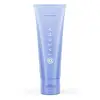What's inside
What's inside
 Key Ingredients
Key Ingredients

 Benefits
Benefits

 Concerns
Concerns

 Ingredients Side-by-side
Ingredients Side-by-side

Water
Skin ConditioningSodium Lauroyl Sarcosinate
CleansingGlycerin
HumectantCocamidopropyl Betaine
CleansingAcrylates Copolymer
Polysorbate 20
EmulsifyingCoco-Glucoside
CleansingGlycol Distearate
EmollientGlyceryl Oleate
EmollientSodium Lactate
BufferingDicaprylyl Ether
EmollientPhenoxyethanol
PreservativeLauryl Alcohol
EmollientParfum
MaskingSodium Chloride
MaskingOrbignya Oleifera Seed Oil
EmollientXanthan Gum
EmulsifyingSodium Hydroxide
BufferingCaprylyl Glycol
EmollientCitric Acid
BufferingPropylene Glycol
HumectantChlorphenesin
AntimicrobialGlyceryl Stearate
EmollientGalactoarabinan
Papain
Skin ConditioningDisodium EDTA
Behenyl Alcohol
EmollientButyrospermum Parkii Butter
Skin ConditioningBenzoic Acid
MaskingMoringa Oleifera Seed Extract
Skin ConditioningHydrogenated Castor Oil
EmollientDisodium Phosphate
BufferingStearyl Alcohol
EmollientProtease
ExfoliatingSubtilisin
Skin ConditioningTocopheryl Acetate
AntioxidantHydrogenated Palm Glycerides Citrate
EmollientTocopherol
AntioxidantPoria Cocos Extract
Skin ConditioningFrog Fat Extract
HumectantWater, Sodium Lauroyl Sarcosinate, Glycerin, Cocamidopropyl Betaine, Acrylates Copolymer, Polysorbate 20, Coco-Glucoside, Glycol Distearate, Glyceryl Oleate, Sodium Lactate, Dicaprylyl Ether, Phenoxyethanol, Lauryl Alcohol, Parfum, Sodium Chloride, Orbignya Oleifera Seed Oil, Xanthan Gum, Sodium Hydroxide, Caprylyl Glycol, Citric Acid, Propylene Glycol, Chlorphenesin, Glyceryl Stearate, Galactoarabinan, Papain, Disodium EDTA, Behenyl Alcohol, Butyrospermum Parkii Butter, Benzoic Acid, Moringa Oleifera Seed Extract, Hydrogenated Castor Oil, Disodium Phosphate, Stearyl Alcohol, Protease, Subtilisin, Tocopheryl Acetate, Hydrogenated Palm Glycerides Citrate, Tocopherol, Poria Cocos Extract, Frog Fat Extract
Water
Skin ConditioningMicrocrystalline Cellulose
AbsorbentPropanediol
SolventSodium Cocoyl Glutamate
CleansingGlycerin
HumectantAcrylates Copolymer
Sodium Caproyl Methyltaurate
CleansingCoco-Betaine
CleansingParfum
MaskingCamellia Sinensis Leaf
PerfumingOryza Sativa Powder
Chondrus Crispus Extract
Skin ConditioningSodium Hyaluronate
HumectantBetaphycus Gelatinum Extract
BleachingLauryl Glucoside
CleansingPotassium Hydroxide
BufferingPolyquaternium-39
Disodium EDTA
Phenoxyethanol
PreservativeEthylhexylglycerin
Skin ConditioningSodium Benzoate
MaskingSodium Carbonate
BufferingAlcohol
AntimicrobialWater, Microcrystalline Cellulose, Propanediol, Sodium Cocoyl Glutamate, Glycerin, Acrylates Copolymer, Sodium Caproyl Methyltaurate, Coco-Betaine, Parfum, Camellia Sinensis Leaf, Oryza Sativa Powder, Chondrus Crispus Extract, Sodium Hyaluronate, Betaphycus Gelatinum Extract, Lauryl Glucoside, Potassium Hydroxide, Polyquaternium-39, Disodium EDTA, Phenoxyethanol, Ethylhexylglycerin, Sodium Benzoate, Sodium Carbonate, Alcohol
 Reviews
Reviews

Ingredients Explained
These ingredients are found in both products.
Ingredients higher up in an ingredient list are typically present in a larger amount.
Acrylates Copolymer is used as a film-forming agent and texture enhancer.
After applied, Acrylates Copolymer forms a thin film cover that helps skin feel more soft. It can help sunscreens become more water-resistant.
It is also used to make a product more thick.
Learn more about Acrylates CopolymerDisodium EDTA plays a role in making products more stable by aiding other preservatives.
It is a chelating agent, meaning it neutralizes metal ions that may be found in a product.
Disodium EDTA is a salt of edetic acid and is found to be safe in cosmetic ingredients.
Learn more about Disodium EDTAGlycerin is already naturally found in your skin. It helps moisturize and protect your skin.
A study from 2016 found glycerin to be more effective as a humectant than AHAs and hyaluronic acid.
As a humectant, it helps the skin stay hydrated by pulling moisture to your skin. The low molecular weight of glycerin allows it to pull moisture into the deeper layers of your skin.
Hydrated skin improves your skin barrier; Your skin barrier helps protect against irritants and bacteria.
Glycerin has also been found to have antimicrobial and antiviral properties. Due to these properties, glycerin is often used in wound and burn treatments.
In cosmetics, glycerin is usually derived from plants such as soybean or palm. However, it can also be sourced from animals, such as tallow or animal fat.
This ingredient is organic, colorless, odorless, and non-toxic.
Glycerin is the name for this ingredient in American English. British English uses Glycerol/Glycerine.
Learn more about GlycerinParfum is a catch-all term for an ingredient or more that is used to give a scent to products.
Also called "fragrance", this ingredient can be a blend of hundreds of chemicals or plant oils. This means every product with "fragrance" or "parfum" in the ingredients list is a different mixture.
For instance, Habanolide is a proprietary trade name for a specific aroma chemical. When used as a fragrance ingredient in cosmetics, most aroma chemicals fall under the broad labeling category of “FRAGRANCE” or “PARFUM” according to EU and US regulations.
The term 'parfum' or 'fragrance' is not regulated in many countries. In many cases, it is up to the brand to define this term.
For instance, many brands choose to label themselves as "fragrance-free" because they are not using synthetic fragrances. However, their products may still contain ingredients such as essential oils that are considered a fragrance by INCI standards.
One example is Calendula flower extract. Calendula is an essential oil that still imparts a scent or 'fragrance'.
Depending on the blend, the ingredients in the mixture can cause allergies and sensitivities on the skin. Some ingredients that are known EU allergens include linalool and citronellol.
Parfum can also be used to mask or cover an unpleasant scent.
The bottom line is: not all fragrances/parfum/ingredients are created equally. If you are worried about fragrances, we recommend taking a closer look at an ingredient. And of course, we always recommend speaking with a professional.
Learn more about ParfumPhenoxyethanol is a preservative that has germicide, antimicrobial, and aromatic properties. Studies show that phenoxyethanol can prevent microbial growth. By itself, it has a scent that is similar to that of a rose.
It's often used in formulations along with Caprylyl Glycol to preserve the shelf life of products.
Water. It's the most common cosmetic ingredient of all. You'll usually see it at the top of ingredient lists, meaning that it makes up the largest part of the product.
So why is it so popular? Water most often acts as a solvent - this means that it helps dissolve other ingredients into the formulation.
You'll also recognize water as that liquid we all need to stay alive. If you see this, drink a glass of water. Stay hydrated!
Learn more about Water